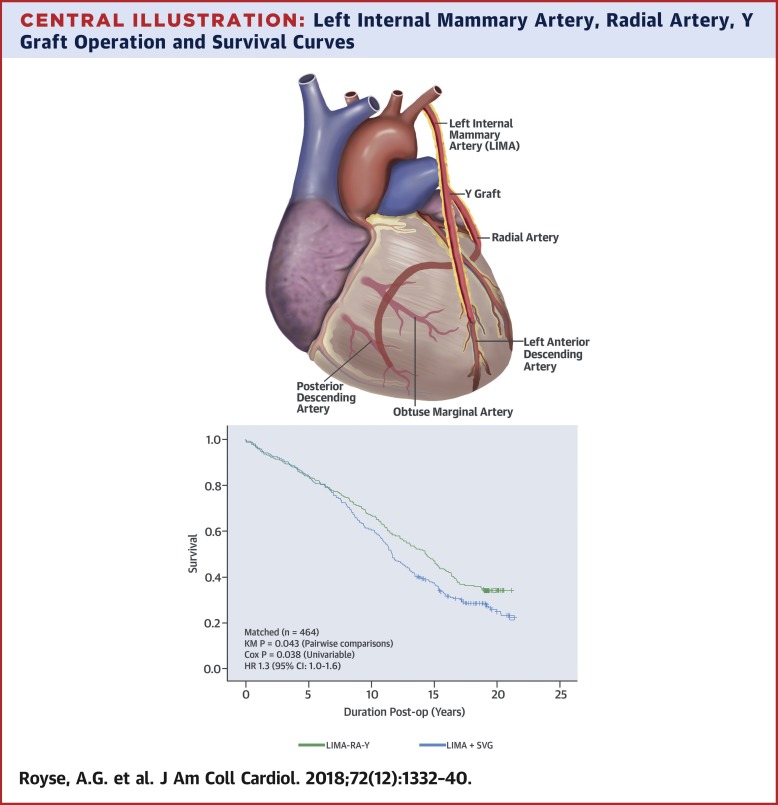当前位置:
X-MOL 学术
›
J. Am. Coll. Cardiol.
›
论文详情
Our official English website, www.x-mol.net, welcomes your
feedback! (Note: you will need to create a separate account there.)
21-Year Survival of Left Internal Mammary Artery–Radial Artery–Y Graft
Journal of the American College of Cardiology ( IF 21.7 ) Pub Date : 2018-09-01 , DOI: 10.1016/j.jacc.2018.06.064 Alistair G Royse 1 , Anthony P Brennan 2 , Jared Ou-Young 3 , Zulfayandi Pawanis 4 , David J Canty 5 , Colin F Royse 6
Journal of the American College of Cardiology ( IF 21.7 ) Pub Date : 2018-09-01 , DOI: 10.1016/j.jacc.2018.06.064 Alistair G Royse 1 , Anthony P Brennan 2 , Jared Ou-Young 3 , Zulfayandi Pawanis 4 , David J Canty 5 , Colin F Royse 6
Affiliation

|
BACKGROUND
In 1999, Royse et al. reported on the left internal mammary artery, radial artery, Y-graft technique (LIMA-RA-Y), which achieves total arterial revascularization (TAR). However, the most common coronary reconstruction remains LIMA and supplementary saphenous vein grafts (LIMA + SVG). OBJECTIVES
The goal of this study was to conduct a survival comparison of LIMA-RA-Y versus the conventional LIMA + SVG. METHODS
Of the original 464 LIMA-RA-Y patients reported (1996 to 1998), 346 were from the Royal Melbourne Hospital. Survival at June 2017 was compared with a group of 534 patients from 1996 to 2003 from the same institution who received LIMA + SVG, or 5,800 patients who received TAR with different grafting configurations. Propensity score matching (PSM) was performed with 1:1 matching using 26 variables. Comparisons used Kaplan-Meier (KM) and Cox proportional hazards methods. LIMA-RA-Y was compared with LIMA + SVG in which all non-left anterior descending artery grafts were performed with either composite RA or aorta-coronary SVG with no use of right internal mammary artery. We also conducted a comparison of LIMA-RA-Y versus TAR. RESULTS
Baseline characteristics of the LIMA-RA-Y group (n = 346) compared with LIMA + SVG (n = 534) after PSM (n = 232 pairs) did not differ (3.3 ± 0.8 grafts per patient). Survival was worse for LIMA + SVG in the unmatched groups (KM, p < 0.001) and for PSM groups (KM, p = 0.043; Cox proportional hazards ratio: 1.3; 95% confidence interval: 1.0 to 1.6; p = 0.038). Survival did not differ between LIMA-RA-Y and other TAR (n = 5,800) patients before, or after, PSM (n = 332 pairs). CONCLUSIONS
Use of LIMA + SVG has worse survival than LIMA-RA-Y in achieving total arterial revascularization.
中文翻译:

左乳内动脉 - 桡动脉 - Y 移植物的 21 年存活率
背景 1999 年,Royse 等人。报道了左乳内动脉、桡动脉、Y 型移植技术(LIMA-RA-Y),该技术实现了全动脉血运重建(TAR)。然而,最常见的冠状动脉重建仍然是 LIMA 和辅助大隐静脉移植(LIMA + SVG)。目的 本研究的目的是对 LIMA-RA-Y 与传统 LIMA + SVG 进行生存比较。方法 最初报告的 464 名 LIMA-RA-Y 患者(1996 年至 1998 年)中,346 名来自皇家墨尔本医院。将 2017 年 6 月的生存率与 1996 年至 2003 年同一机构的 534 名接受 LIMA + SVG 的患者或 5,800 名接受不同移植配置的 TAR 患者进行比较。使用 26 个变量以 1:1 匹配进行倾向评分匹配 (PSM)。比较使用 Kaplan-Meier (KM) 和 Cox 比例风险方法。LIMA-RA-Y 与 LIMA + SVG 进行了比较,其中所有非左前降支移植物均使用复合 RA 或主动脉 - 冠状动脉 SVG 进行,不使用右侧乳内动脉。我们还对 LIMA-RA-Y 与 TAR 进行了比较。结果 在 PSM(n = 232 对)后,LIMA-RA-Y 组(n = 346)与 LIMA + SVG(n = 534)的基线特征没有差异(每位患者 3.3 ± 0.8 个移植物)。LIMA + SVG 在未匹配组(KM,p < 0.001)和 PSM 组(KM,p = 0.043;Cox 比例风险比:1.3;95% 置信区间:1.0 至 1.6;p = 0.038)中的存活率更差。LIMA-RA-Y 和其他 TAR(n = 5,800)患者在 PSM 之前或之后(n = 332 对)的存活率没有差异。
更新日期:2018-09-01
中文翻译:

左乳内动脉 - 桡动脉 - Y 移植物的 21 年存活率
背景 1999 年,Royse 等人。报道了左乳内动脉、桡动脉、Y 型移植技术(LIMA-RA-Y),该技术实现了全动脉血运重建(TAR)。然而,最常见的冠状动脉重建仍然是 LIMA 和辅助大隐静脉移植(LIMA + SVG)。目的 本研究的目的是对 LIMA-RA-Y 与传统 LIMA + SVG 进行生存比较。方法 最初报告的 464 名 LIMA-RA-Y 患者(1996 年至 1998 年)中,346 名来自皇家墨尔本医院。将 2017 年 6 月的生存率与 1996 年至 2003 年同一机构的 534 名接受 LIMA + SVG 的患者或 5,800 名接受不同移植配置的 TAR 患者进行比较。使用 26 个变量以 1:1 匹配进行倾向评分匹配 (PSM)。比较使用 Kaplan-Meier (KM) 和 Cox 比例风险方法。LIMA-RA-Y 与 LIMA + SVG 进行了比较,其中所有非左前降支移植物均使用复合 RA 或主动脉 - 冠状动脉 SVG 进行,不使用右侧乳内动脉。我们还对 LIMA-RA-Y 与 TAR 进行了比较。结果 在 PSM(n = 232 对)后,LIMA-RA-Y 组(n = 346)与 LIMA + SVG(n = 534)的基线特征没有差异(每位患者 3.3 ± 0.8 个移植物)。LIMA + SVG 在未匹配组(KM,p < 0.001)和 PSM 组(KM,p = 0.043;Cox 比例风险比:1.3;95% 置信区间:1.0 至 1.6;p = 0.038)中的存活率更差。LIMA-RA-Y 和其他 TAR(n = 5,800)患者在 PSM 之前或之后(n = 332 对)的存活率没有差异。

































 京公网安备 11010802027423号
京公网安备 11010802027423号